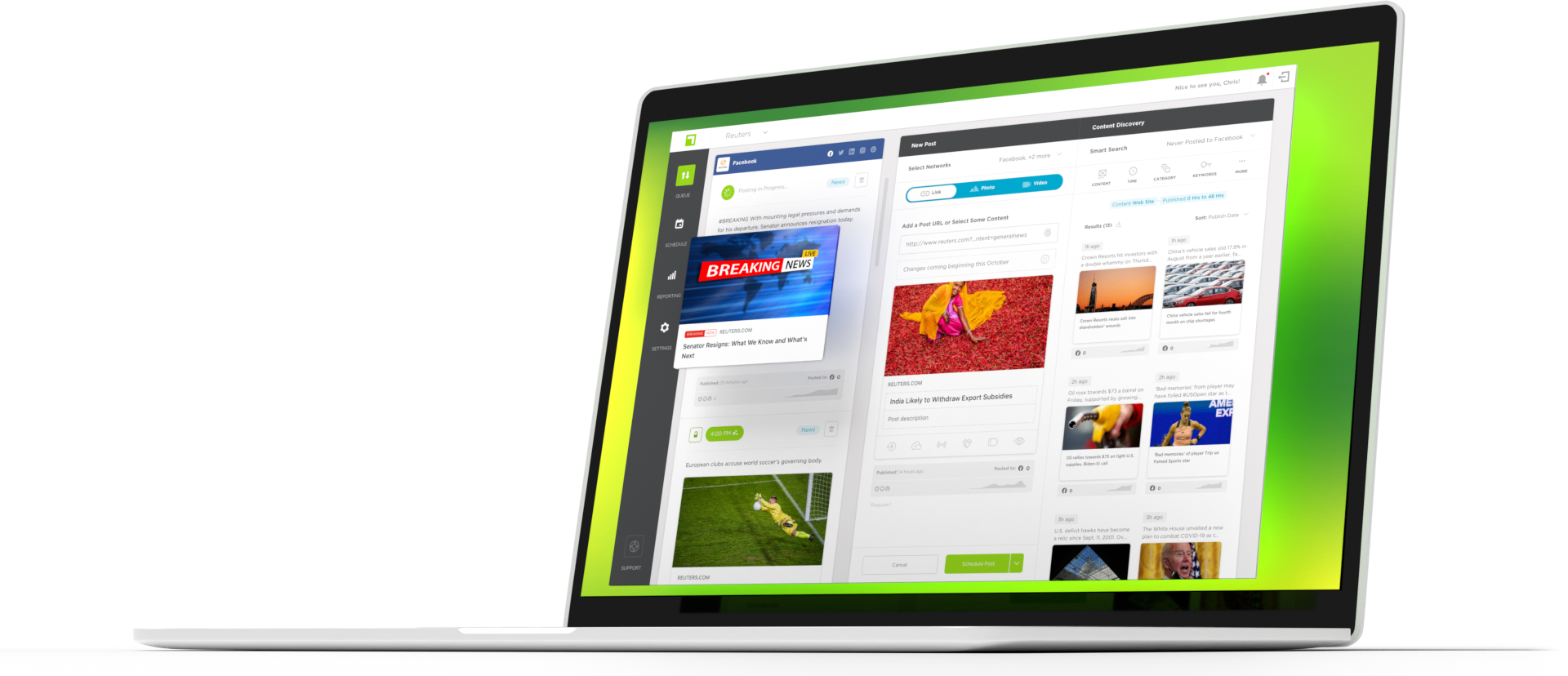Multi-platform social media posting is a complicated topic. As the number of platforms continues to expand, the sheer volumes of content needed can easily exceed the ability to produce. And how can you possibly keep up with all of the tagging, hash-tagging, sharing, image aspect ratios, Stories, and, well, writing for your site?
The answer is likely that you are going to have to prioritize.
Let’s start at the beginning.
Set your goals for each platform
You’re going to need to figure out what you’re trying to accomplish with each platform and create/distribute accordingly.
Some suggestions:
- Facebook is still a significant traffic driver, but most publishers have seen a drop from pages. If you have a marketing budget, you’re going to need to use it. Facebook is not as publisher-friendly as it used to be, and you’ll need to be prepared to spend to get the reach you’re after.
- Instagram is trickier as a traffic driver, primarily due to the lack of link placement within the platform. The addition of the link sticker has made traffic from stories accessible, though!
- TikTok is still the wild west. The audience is quite different (and younger) than Facebook and Instagram, and the content is a little higher touch, but the opportunities are abundant.
- Pinterest is still a sales monster. Again, the content is a bit higher touch and likely requires a bit more design, but the life of a pin is exponentially higher than any other platform.
- YouTube is the second largest search engine on the internet behind Google. Spend some time keywording and creating searchable content
- Twitter is about connecting directly with your consumers or other influencers. Be conversational and post frequently. You may or may not drive traffic, but focusing on your conversations is essential.
Formatting content for each platform.
You won’t need to post everything everywhere. But there are some ways to streamline and customize each piece for your purposes.
Links
Links are the most valuable for most brands and publishers, as you’re able to drive traffic back to the only platform you truly own: Your website. They can also be tricky, as every forum has different options for sharing links. Your best bet is to use the native link fields that are available. Check the aspect ratios on the post to make sure that they will pull through. As an alternative, you can use a plugin like Yoast to create social setups in your website backend, uploading correctly-sized images for each platform.
Facebook is likely going to give you the most significant return on link content. However, if you want to dive into Instagram, we can help! Click here for a link at how to drive link traffic with Instagram.
Twitter is unique in that you have to worry very little about posting cadence. You can post a link a dozen times if you won’t – be sure to update the copy and images. If you set up the link in different ways, you could attract a diverse audience.
To summarize: Use native link fields, make sure your images are set to proper aspect ratios, and take the time to hashtag and write appropriate copy and you should be good to go!
Social copy
Yes, this should be platform-specific. There are formatting concerns and different features that will not work out of context. For example, including hashtags should be done on Instagram, but not on Facebook. It is also important (and different!) on Pinterest. It would be best to keep your hashtags to a total of 1-3 hashtags on Twitter.
If you’re tagging pages, profiles, etc., in one platform, make sure to format it correctly to tag them on another platform. That Instagram tag will not work on Facebook!
Beyond the technical challenges, your TikTok audience will be very different from your Instagram audience! Make sure that you know who your audience is, and you speak to them accordingly while staying on brand.
Images
Consider the aspect ratio for images on each platform. Make sure that they fit! Awkwardly cropped images, especially those that have text, look messy and can detract from the display.
Facebook Image Guidelines
Shared Image:
- Recommended upload size of 1,200 x 630 pixels.
- Will appear in Feed at a max width of 470 pixels (will scale to a max of 1:1).
- Will appear on page at a max width of 504 pixels (will scale to a max of 1:1).
Shared Link:
- Recommended upload size of 1,200 x 628 pixels.
- Square Photo: Minimum 154 x 154px in Feed.
- Square Photo: Minimum 116 x 116 on-page.
- Rectangular Photo: Minimum 470 x 246 pixels in Feed.
- Rectangular Photo: Minimum 484 x 252 on-page.
Instagram Image Guidelines
Feed Images:
- The size of Instagram images has been increased to 1080 x 1080 pixels.
- Instagram still scales these photos down to 612 x 612 pixels.
- Appear in Feed at 510 x 510 pixels.
- Square or rectangle photos: make sure to maintain an aspect ratio between 1:1 or 1.91:1.
- For portrait (4:5) photos, recommended dimensions are 1080 x 1350 pixels.
Story Images:
- Recommended resolution is 1080 x 1920.
- The minimum resolution is 600 x 1067.
- The aspect ratio is 9:16.
For all other aspect ratios, including LinkedIn, YouTube, Pinterest, Twitter, and more, here’s a guide.
Videos
Every platform has multiple video options. Stories, in Feed, embedded from YouTube, IGTV, Live… where do you even start?
Whatever makes you comfortable. IGTV and Instagram Stories have the same aspect ratio as do Facebook Stories. Those are fine to share! You can also share a feed video to both Instagram and Facebook. There are many ways to crosspost your video.
Some things to consider:
- Instagram Feed limits your video to 1 minute.
- Instagram stories limits to 15 seconds. Facebook stories are 20 seconds. If you create a 19-second video for Facebook stories, the video will cut off the end on Instagram, or the last few seconds will be in a new story. Formatting for the 15-second limit may work better if you intend to crosspost.
- IGTV can be as long as 60 minutes. You can also share your IGTV to Stories and your Feed. You can choose to post a 60-second preview in your Feed, prompting the user to tap to finish the video in IGTV.
- Facebook videos are limited to 240 minutes.
- Twitter’s video length limit is 140 seconds.
How do you decide what goes where?
Now that we understand the technical limitations of each platform, we can evaluate what content fits where. The truth is that, while there are guidelines for each forum and we can paint the demographics of each one with large strokes, the rules are always flexible. It is going to take some time and energy to figure out what works with your audience. Multi-platform social media posting is not one size fits all.
You’re going to look at your audience and your platform goals, content capabilities, and brand voice, then make decisions based on those elements. Don’t worry; we’ll walk through this.
Let’s say you have an important promotion that you want to ensure is seen across all platforms.
Here is an example of how we could tackle multi-platform social media posting so it actually gets seen.
- Facebook: You can either share a short link in the caption of a Shared image or video or share a link post with an appropriate featured image. Or both! Those are all options on Facebook. Make sure that your aspect ratios are correct for Facebook.
- Create a Facebook story with proper aspect ratios.
- In this case, the video and Story should both work on Instagram’s respective counterparts so that you can share the Facebook story to Insta stories and a video to the Insta feed. You’ll want to add hashtags for Instagram and tag appropriate accounts if applicable.
- Maybe you want to do a Q&A to help bring more visibility on Instagram. Go live! Once you go live, you can store that live to IGTV.
- You can also go live on Facebook! Lives can also be viewed after the fact and will live in your video section. Make sure you go back and caption appropriately and tag relevant accounts! It’ll make it much easier to find after the fact.
- Tweet! Send out a link tweet (or 3!). Send out the images or videos on Twitter. Maybe just some text tweets tagging people involved. Get creative! Twitter just announced an entirely flexible aspect ratio, so you have a lot more room to play with images there.
- Do you have a YouTube channel? Format your video for YouTube! Add annotations, captions, whatever you would like, and keyword it well, so it’s searchable.
- Get beautiful images and create some Pins! Pinterest also has a potent search tool. Make sure you SEO your posts and keyword your captions well.
All of this is just an example of things to think about when tackling the four most prominent social platforms. Execution is everything, and your audience will notice if you take the time to present your content well! The results are worth it.
Ready to learn how to increase your social media monetization? With our AI powered tool, you can make multi-platform social media posting easy——contact us today to learn more! Be sure to sign up for our newsletter to get the latest news on social media.

